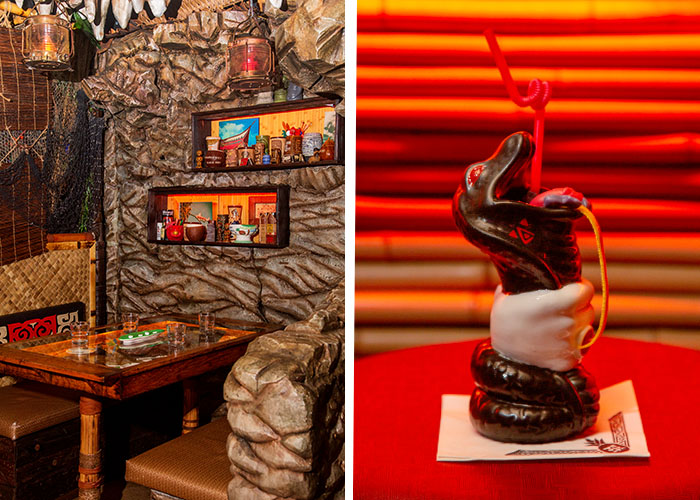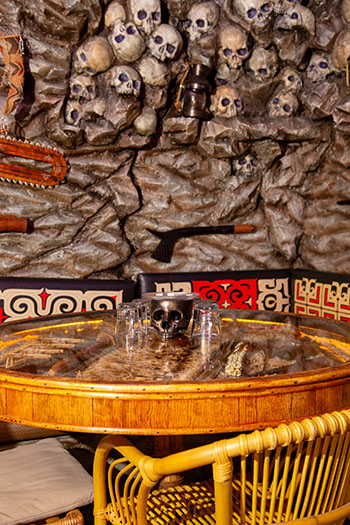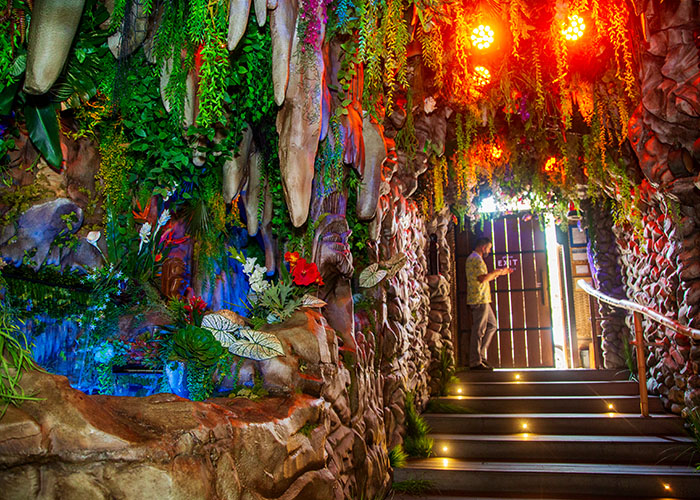Rum Gets Its Due at Tiki Tatsu-Ya

Rum Gets Its Due at Tiki Tatsu-Ya
Baby, it’s hot outside. This versatile Caribbean spirit is the answer
By Laurel Miller
Photos by Holly Cowart
“Rum is synonymous with escapism,” says Cory Starr, beverage manager at Tiki Tatsu-Ya. “Drinking Scotch by the fire isn’t the same vibe.”
The sugar cane distillate is also synonymous with summery cocktails, from icy daiquiris or a Queen’s Park Swizzle to technicolor tiki drinks. The latter are Starr’s specialty. Before he helped open South Lamar’s perennially packed subterranean tiki bar, he cut his teeth bartending in Hawaii and at Chicago’s Three Dots and A Dash, one of the nation’s preeminent tiki bars.
 “As a bartender, I love the versatility and diversity of rum,” he says. “Depending upon the raw ingredient (sugar cane juice or molasses), country, terroir and distillery, there are rums with profiles similar to tequila, mezcal, Scotch or bourbon. I learn something new every day because there are so many brands, and there’s more care being taken with distilling and aging, but rum also has a fascinating history.”
“As a bartender, I love the versatility and diversity of rum,” he says. “Depending upon the raw ingredient (sugar cane juice or molasses), country, terroir and distillery, there are rums with profiles similar to tequila, mezcal, Scotch or bourbon. I learn something new every day because there are so many brands, and there’s more care being taken with distilling and aging, but rum also has a fascinating history.”
It was Christopher Columbus who first introduced sugar cane, which is native to Asia, to the Americas and the Caribbean in 1493. The first mills and plantations began operating in the Caribbean not long after, setting the stage for the islands to become the epicenter of rum production.
RELATED: Vista Brewing Brings Barrel-Aged, Collaborative Beers to the Hill Country
 The exact origin of rum is unknown, but many historians believe that Barbados was the first to distill sugar cane juice. The spirit is also crucial to the culture and economies of Martinique, Jamaica, Cuba, Barbados, Trinidad and St. Lucia. In Central and South America, Nicaragua, Guyana, Venezuela and Colombia are also known for their excellent aged rums.
The exact origin of rum is unknown, but many historians believe that Barbados was the first to distill sugar cane juice. The spirit is also crucial to the culture and economies of Martinique, Jamaica, Cuba, Barbados, Trinidad and St. Lucia. In Central and South America, Nicaragua, Guyana, Venezuela and Colombia are also known for their excellent aged rums.
Aged rums vary in color from gold to nearly black. Depending upon the type of cane derivative, distillation method (pot stills are said to yield a more flavorful spirit), origin, type of wood and time spent in the cask, their flavors vary and may reflect hints of caramel, earth, coffee, cacao, leather, sulfur, citrus, baking spices, candied fruit or vanilla.
Even unaged (white) rums can exhibit great diversity, as with Martinique and Guadeloupe’s Rhum Agricole, which is distilled from fresh, rather than fermented cane juice, and clairin, which is Haitian Agricole made from wild sugar cane. These spirits frequently draw comparisons to mezcal for their grassy, earthy, terroir-centric characteristics.
 Tiki Tatsu-Ya currently boasts 220 different types of rum and counting — possibly the largest collection in Texas. The curation includes rhum Agricole, clairin, pot still, blackstrap, overproof and aged spirits from the Caribbean, Latin America and the United States. And while not all classic tiki cocktails contain rum, it’s impossible to overlook how essential the spirit is to the genre’s sun-drenched ethos of escapism.
Tiki Tatsu-Ya currently boasts 220 different types of rum and counting — possibly the largest collection in Texas. The curation includes rhum Agricole, clairin, pot still, blackstrap, overproof and aged spirits from the Caribbean, Latin America and the United States. And while not all classic tiki cocktails contain rum, it’s impossible to overlook how essential the spirit is to the genre’s sun-drenched ethos of escapism.
“The ubiquitousness of sugar cane cultivation has strongly influenced tiki culture,” says Starr. “While most of us associate tiki with Polynesia, it’s also informed the Caribbean, as seen in drinks that were created there, like the Painkiller and Rum Punch.”
Starr creates riffs on tiki classics at his bar, frequently using up to five rums for a single cocktail.
 “Rum differs so much, depending upon where it’s from, but I really like to highlight an entire island’s rums in one drink, to represent the place as a whole, while also blending with other islands to create a more balanced cocktail,” explains Starr.
“Rum differs so much, depending upon where it’s from, but I really like to highlight an entire island’s rums in one drink, to represent the place as a whole, while also blending with other islands to create a more balanced cocktail,” explains Starr.
Supply shortages and distribution issues have made that singular focus challenging, so Starr and his team are constantly modifying recipes to ensure every drink is at its best.
RELATED: The Best Restaurant Happy Hours in Austin Right Now
 The oft-abused Mai Tai is perhaps the best example of Starr’s skill when it comes to building harmonious flavor profiles. In the wrong hands, a Mai Tai is cloying or flat, rather than bright, refreshing and balanced. Currently, it’s made with a blend of Martinican Rhum JM and Neisson Agricole Blanc, Jamaica’s Smith & Cross, Appleton 12 and Appleton Estate, and St. Lucia’s Chairman’s Original, combined with housemade miso orgeat, lime and mandarin. It’s a lush, crushable cocktail garnished with fruit slices and a fragrant bouquet of mint.
The oft-abused Mai Tai is perhaps the best example of Starr’s skill when it comes to building harmonious flavor profiles. In the wrong hands, a Mai Tai is cloying or flat, rather than bright, refreshing and balanced. Currently, it’s made with a blend of Martinican Rhum JM and Neisson Agricole Blanc, Jamaica’s Smith & Cross, Appleton 12 and Appleton Estate, and St. Lucia’s Chairman’s Original, combined with housemade miso orgeat, lime and mandarin. It’s a lush, crushable cocktail garnished with fruit slices and a fragrant bouquet of mint.
Starr learned to create singular island profiles at Three Dots, but the concept of using multiple rums for tiki cocktails was developed by one Ernest Raymond Beaumont Gannt, a.k.a. Donn Beach, the creator of the Mai Tai. Beach opened Don the Beachcomber — the birthplace of tiki culture — in Los Angeles in 1937.
“He liked to say, ‘What one rum can’t do, three rums can,’” says Starr. “We’re just taking that to the next level, using different rums to create a fully balanced profile, along with other components, many of which are made in-house. Our goal is to always use elements that elevate our drinks, which isn’t always the case with modern tiki.”
 Even an Old-Fashioned — decidedly not a classic tiki cocktail — undergoes a sub-tropical transformation in Starr’s hands. He uses one of his favorite rums, Blackadder Jamaica Monymusk Raw Cask Rum 11 Year, which is aged in Scotland. The cold climate necessitates a longer aging period, yielding an amber spirit with a “an earthy, jungle profile,” says Starr. Combined with housemade Chinese “herbstura” bitters and Kukoto (black Okinawan sugar) syrup, the result is a nuanced, seductive cocktail that aptly demonstrates how complex and versatile aged rum can be.
Even an Old-Fashioned — decidedly not a classic tiki cocktail — undergoes a sub-tropical transformation in Starr’s hands. He uses one of his favorite rums, Blackadder Jamaica Monymusk Raw Cask Rum 11 Year, which is aged in Scotland. The cold climate necessitates a longer aging period, yielding an amber spirit with a “an earthy, jungle profile,” says Starr. Combined with housemade Chinese “herbstura” bitters and Kukoto (black Okinawan sugar) syrup, the result is a nuanced, seductive cocktail that aptly demonstrates how complex and versatile aged rum can be.
“Rum isn’t for the faint of heart,” says Starr. “It’s an adventurous spirit like no other, ranging from smooth and easy-drinking to bold and complex. My advice is to try a rum from a specific island and go from there. Rum is a collector’s spirit because it’s so diverse. You’ll never get bored once you’re hooked.”
RELATED: Tiki Culture is Back in Austin and Better Than Ever
